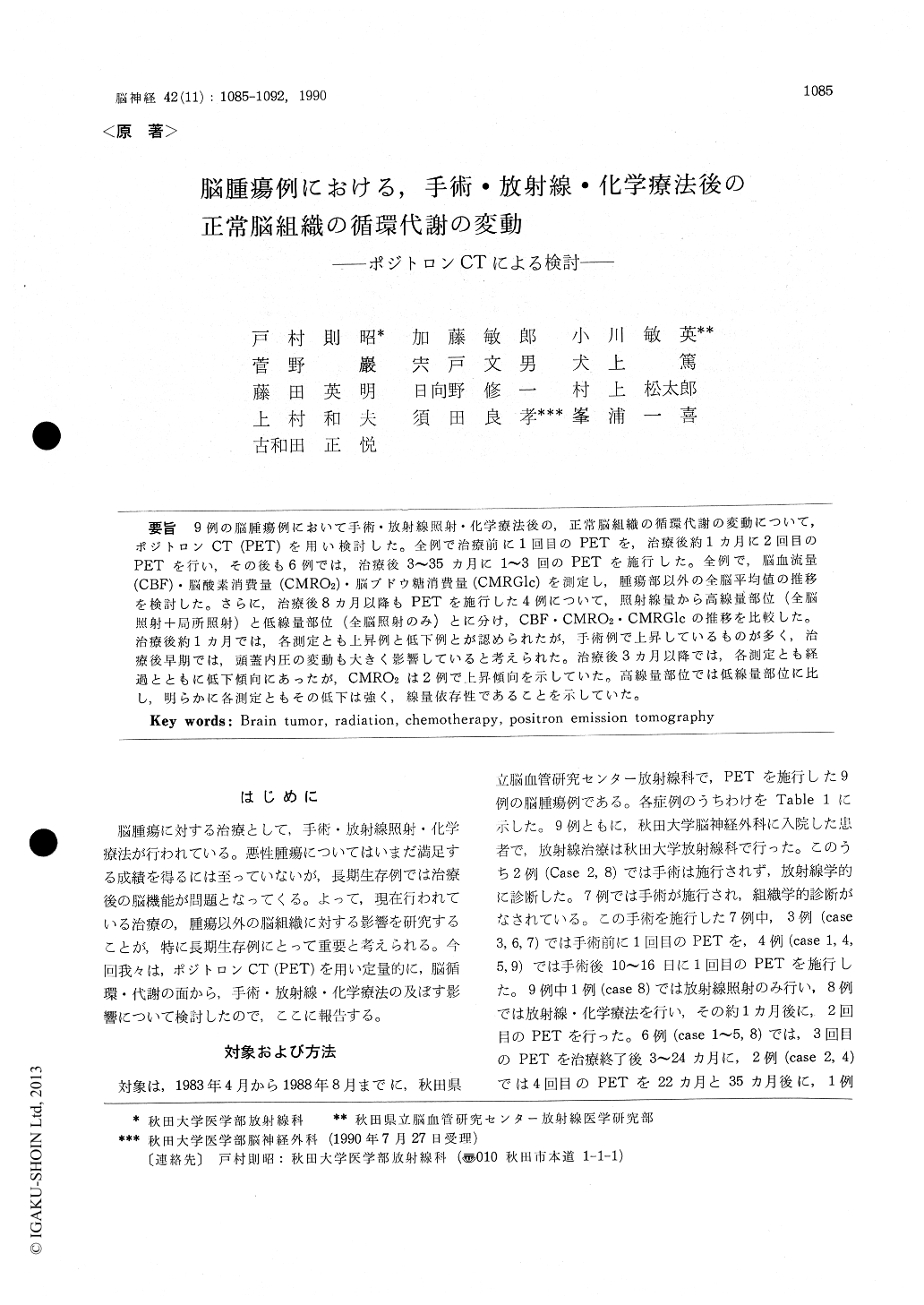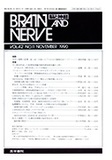Japanese
English
- 有料閲覧
- Abstract 文献概要
- 1ページ目 Look Inside
9例の脳腫瘍例において手術・放射線照射・化学療法後の,正常脳組織の循環代謝の変動について,ポジトロンCT(PET)を用い検討した。全例で治療前に1回目のPETを,治療後約1カ月に2回目のPETを行い,その後も6例では,治療後3〜35カ月に1〜3回のPETを施行した。全例で,脳血流量(CBF)・脳酸素消費量(CMRO2)・脳ブドウ糖消費量(CMRGlc)を測定し,腫瘍部以外の全脳平均値の推移を検討した。さらに,治療後8カ月以降もPETを施行した4例について,照射線量から高線量部位(全脳照射十局所照射)と低線量部位(全脳照射のみ)とに分け,CBF・CMRO2・CMRGIcの推移を比較した。治療後約1カ月では,各測定とも上昇例と低下例とが認められたが,手術例で上昇しているものが多く,治療後早期では,頭蓋内圧の変動も大きく影響していると考えられた。治療後3カ月以降では,各測定とも経過とともに低下傾向にあったが,CMRO2は2例で上昇傾向を示していた。高線量部位では低線量部位に比し,明らかに各測定ともその低下は強く,線母依存性であることを示していた。
The changes of cerebral blood flow (CBF) and metabolism of normal brain tissue after surgery, radiation, and chemotherapy in brain tumor pati-ents were measured by positron emission tomogr-aphy (PET). The subjects consisted of 6 men and 3 women, and were from 11 to 62 years old. Those were four patients with glioblastomas, one patient with malignant oligodendroglioma, one patient with astrocytoma grade II, one patient with astro-cytoma grade III, one patient with pontine glioma, one patient with pineal germinoma. Seven pati-ents were operated and pathohistologically diagno-sed. Two patients with pineal germinoma and po-ntine glioma were not operated and radiologically diagnosed. Of 7 operated patients, first PET was performed before operation in 3 patients, and from 10 to 16 days after operation in 4 patients. Fol-lowing first PET, the patients were treated with irradiation (1 case), or with both irradiation and chemotherapy (8 cases). The total radiation dose for tumor was from 59 to 61 Gy distributed in aperiod of 6-8 weeks. Whole brain irradiation was performed up to 30 or 40 Gy, with a remaining do-simetry (20-30 Gy) focused on the tumor field. Chemotherapy consisted of intravenous administra-tion of ACNU and oral administration of FT-207. Second PET was performed 1 month after therapy (9 cases), and third PET was performed from 4 to 24 months after therapy (6 cases). Fourth PET was performed in 2 patients (22 and 35 months af-ter therapy), and fifth PET was performed in one patient (35 months after therapy). PET was car-ried out parallel to the orbitomeatal plane using HEADTOME III scanner, of which spatial resolu-tion in clinical use was 10 mm full width at half maximum in the image plane. CBF and cerebral metabolic rate of oxygen (CMRO2) were measured by the 1515O-steady state technique. Cerebral meta-bolic rate of glucose (CMRG1c) was measured by the 18F-labelled 2-fluoro-2-deoxy-D-glucose (18F-FDG) method. For the quantitative analysis of CBF, CMRO2 and CMRGlc, elliptic regions of in-terests (ROIs), varying in size from 10 to 30mm, were used in the regions without tumor.
In the second PET performed 1 month after the-rapy, CBF, CMRO2, and CMRGlc increased in most of operated patients. After the second PET, CBF, CMRO2, and CMRGlc showed a tendency to decr-ease in most of patients, but CMRO2 in two pati-ents showed a tendency to increase. In the regi-ons irradiated in the high dcse as much as in the tumor, its CBF, CMRO2 and CMRGlc decreased more strongly than those in the regions irradiated only by the whole brain irradiation.

Copyright © 1990, Igaku-Shoin Ltd. All rights reserved.


